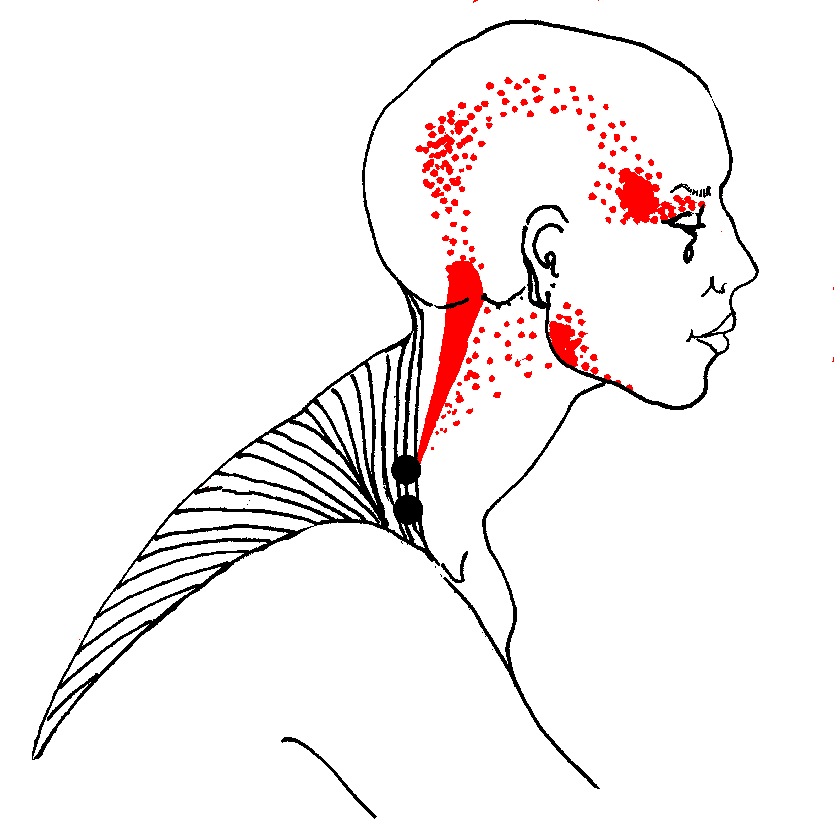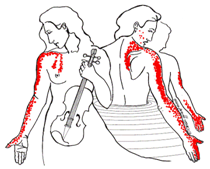Myofascial Trigger Point Therapy - What Is It?
Myofascial Made Simple
The word myofascial means muscle tissue (myo) and the connective tissue in and around it (fascia). Myofascial pain often results from muscle injury or repetitive strain. When stressed or injured, muscles often form trigger points, like contracted knots, that cause pain and tightness.
Myofascial Pain and Trigger Points: Getting to the Point
Myofascial trigger points are an extremely common cause of pain. Trigger points are painful when pressed on, cause a shortening of the muscle fibers, and have a special property called referred pain. Referred pain means that a trigger point in one muscle can create pain in another area.
For instance, when the muscle at the top of your shoulder (trapezius) has a trigger point it will refer pain up the side of your neck and head causing a headache. Active myofascial trigger points in the muscles of the shoulder neck and face are a common source of headaches. In many instances, the headache has the features of so-called tension headaches, but there is increasing acceptance that myofascial trigger points may initiate classical migraine headaches or be part of a mixed tension/migraine headache complex.
Muscles make up between 36-42% of body weight, on average. They are a large percentage of our total weight and have a corresponding impact on our health. When all is in working order, muscles allow us to perform normal activities with ease. When our muscles harbor trigger points, we experience pain, stiffness and tension, physical limitation, and loss of normal function.
Factors commonly cited as predisposing to trigger point formation include but are not limited to: de-conditioning, poor posture, repetitive mechanical stress, mechanical imbalance (e.g. leg length inequality), joint disorders, non-restorative sleep, and vitamin deficiencies.
A diagnosis of Myofascial Pain Syndrome or Chronic Myofascial Pain means that the primary source of your symptoms are from these myofascial trigger points. Often, trigger points are present secondary to other sources of pain, such as arthritis or bulging discs. The trigger points may actually be causing the painful symptoms attributed to these conditions. As such, they are often called "the great mimickers".
Diagnoses include:
- Back pain
- Headaches
- Neck pain
- Rotator cuff (shoulder) pain
- Jaw pain (TMJD)
- Tennis elbow
- Carpal tunnel syndrome
- Hand and arm pain
- Repetitive Strain Injuries
- Pelvic pain
- Hip pain
- "Sciatic" pain (buttock and leg pain)
- Leg and knee pain
- Plantar fasciitis (foot) pain
- Tendinitis/tendinopathy
- Bursitis
- Arthritis
- Disc pain (bulge/rupture/herniation) and radiculopathy
- Frozen shoulder
- Fibromyalgia
- and MUCH more
Muscles have been an under-treated cause of pain. In fact, with a specialized area of medicine for almost every area of the body (heart, eyes, lungs, intestines, kidneys, etc.), oddly, there is no muscle specialty in medicine. Myofascial pain from trigger points is often overlooked as a possible source of pain by those seeking relief.
"Muscle is an orphan organ. No medical specialty claims it. As a consequence, no medical specialty is concerned with promoting funded research into the muscular causes of pain, and medical students and physical therapists rarely receive adequate primary training in how to recognize and treat myofascial trigger points. — David G.Simons, MD pioneer in myofascial pain and trigger points and aerospace physician |
Unfortunately, common though the condition may be, the diagnoses and treatment of Myofascial Pain have yet to be included in most medical training. The majority of patients seeking relief from pain are still treated with the traditional approach of anti-inflammatory medications, muscle relaxants, anti-depressant medications, and/or strengthening programs. These prove ineffective, if not detrimental, as trigger points do not respond to them and may be aggravated by further straining (strengthening exercises). Currently, there is no evidence that any form of drug treatment eliminates myofascial trigger points. NSAIDs and other analgesics usually provide moderate but very temporary symptomatic relief.
It is encouraging that myofascial trigger points are becoming more commonly considered when physicians diagnose their patients. Some primary care physicians, regularly administer trigger point injections. Some recognize the presence of trigger points and refer to Myofascial Trigger Point Therapists. Those who do, enjoy an enhanced success rate and grateful patients.
Research on Trigger Points
Patients evaluated in one pain management center were found to have a myofascial component to their pain in 95% of cases (Gerwin RD. A study of 96 subjects examined for both fibromyalgia and myofascial pain. J Musculoskeletal Pain 1995; 3 (suppl. 1):121-5.). There is increasing awareness that active myofascial trigger points often play a role in the symptoms of patients with tension headaches (Fernandez-de-Las-Penas C, onso-Blanco C, Cuadrado ML, Gerwin RD, Pareja JA. Myofascial trigger points and their relationship to headache clinical parameters in chronic tension-type headache. Headache 2006; 46(8):1264-72.), low back pain, neck pain (Fernandez-de-Las-Penas C, onso-Blanco C, Miangolarra JC. Myofascial trigger points in subjects presenting with mechanical neck pain: A blinded, controlled study. Man Ther 2006; ), temporomandibular pain, forearm and hand pain, postural pain (Treaster D, Marras WS, Burr D, Sheedy JE, Hart D. Myofascial trigger point development from visual and postural stressors during computer work. J Electromyogr Kinesiol 2005;), pelvic/urogenital pain syndromes.
How Trigger Points Are Formed
The damage to muscle and connective tissue which results in trigger points can occur in several ways. It can happen as the result of:
- Repetitive overuse injuries (using the same body parts in the same way hundreds of times on a daily basis) from activities such as typing/mousing, handheld electronics, gardening, home improvement projects, work environments, etc.
- Sustained loading as with heavy lifting, carrying babies, briefcases, boxes, wearing body armor, or lifting bedridden patients.
- Habitually poor posture due to our sedentary lifestyles, de-conditioning, and poorly designed furniture
- Muscle clenching and tensing due to mental/emotional stress.
- Direct injuries such as a blow, strain, break, twist, or tear. Think car accidents, sports injuries, falling down stairs, and the like.
- Surprisingly, trigger points can even develop due to inactivity such as prolonged bed rest or sitting
"Many researchers agree that acute trauma or repetitive micro-trauma may lead to the development of a trigger point. Lack of exercise, prolonged poor posture, vitamin deficiencies, sleep disturbances, and joint problems may all predispose to the development of micro-trauma." — David J. Alvarez, D.O., and Pamela G. Rockwell, D.O. for the American Family Physician |
Active Trigger Points Cause Pain
After forming, trigger points have two phases, active and latent. The active, painful phase of the trigger point is the one that produces the unrelenting, debilitating pain symptoms and which motivates people to seek relief. The active trigger point hurts when pressed with a finger and causes pain around it and in other areas. It causes the muscle in which it's located to be weak and due to the taut bands, to have limited flexibility. The active trigger point referral symptom may feel like a dull ache, deep, pressing pain, burning, or a sensation of numbness and fatigue. It can also cause sweating, tearing of the eyes, goosebumps, and dizziness. The affected dense, shortened muscles, laden with taut bands may even compress and entrap nerves, leading to another secondary set of symptoms. If unaddressed or ineffectively treated, eventually, other muscles around the dysfunctional one may be required to "take up the slack", becoming stressed and developing secondary trigger points. It is not unusual for chronic pain patients to have multiple, overlapping referred pain patterns, making diagnosis and treatment more complex. It is easy to see why this widespread pain is often mistaken for Fibromyalgia - a related but separate diagnosis.
Latent Trigger Points Matter Too
Trigger points can also lie quietly in muscles, sometimes for years. This type of trigger point is called latent. Latent trigger points are very common. Unless you press on the trigger point and feel the tenderness, you probably don't know they are there. Most people have at least a few. Latent trigger points may persist for years after apparent recovery from injury. Latent trigger points cause:
- Restricted movement
- Distorted muscle movement patterns
- Stiffness and weakness of the affected muscle
They generally do not cause pain unless compressed. Many things can cause a trigger point to become active. An old injury that periodically re-surfaces (that "trick knee" or low back "going out") may very likely be due to latent trigger points "waking up" and becoming active when aggravated by muscle overload, a cold draft, fatigue, infection, illness, or stress.
How Many Trigger Points Can I Have?
Since a trigger point is an abnormal biochemical and mechanical area in contracted muscle tissue, the number and exact location on each person can vary. All muscle tissue is potentially prone to developing trigger points. Sometimes people have one trigger point but more often they have many. Prolonged referral of pain and weakness from one trigger point to another area of the body will generally cause other trigger points to develop in that area. These, in turn, if left untreated, can activate and also refer pain, creating multiple pain patterns. The more areas that have pain and the longer you have had the pain, the more trigger points you are likely to have. It is rare for someone with pain to only have one or two muscles with trigger points.
Establishing if Trigger Points Are Present
A skilled practitioner who has been trained to recognize the symptoms of myofascial pain and palpate muscles for myofascial trigger points can assess whether myofascial trigger points are present. There are no commonly available lab tests or imaging studies that can confirm the diagnosis at this time. Myofascial trigger points can be seen on special MRI scans and special ultrasounds but these are currently only used in research.
"Myofascial pain syndromes are muscle pain syndromes that are classified as musculoskeletal disorders. They have a defined pathophysiology that leads to the development of the characteristic taut or hard band in the muscle that is tender and that refers pain to distant sites. MPS can be regional or generalized. If an MPS becomes chronic, it tends to generalize, but it does not become fibromyalgia. It can be classified both as a primary disorder without other medical illness or as a secondary pain syndrome that occurs as a result of another process. MPS may persist long after the initiating event or condition has passed, but it is nonetheless a muscle disease that can be satisfactorily treated." Robert D. Gerwin, MD
Treating Myofascial Pain with Trigger Point Therapy
Treating each trigger point is relatively simple. Treating the whole myofascial pain syndrome so that pain fully goes away is a more complicated process.
"You cannot strengthen a muscle that has a trigger point, because the muscle is already physiologically contracted. Too many physical therapists see a weakened muscle and immediately attempt to strengthen it without testing for the presence of trigger points. Attempts at strengthening a muscle with trigger points will only cause the trigger points to worsen..." — Devin Starlanyl, MD author of Fibromyalgia and Chronic Myofascial Pain Syndrome: A Survivor's Manual |
Since a trigger point is the contraction mechanism of the muscle locked into a shortened position, the treatment of the trigger point involves unlocking that contraction mechanism (sarcomere). This can be achieved in several ways. Trigger Point Pressure Release (David Simons, MD and Janet Travell, MD) involves applying pressure with a finger or other instrument to the trigger point and increasing the pressure as the trigger point "releases" and softens. There are a number of variations on this technique and a skilled practitioner will choose which is right for each patient and muscle treated.
Other techniques often used include Spray and Stretch which is a technique that uses a vapor-coolant spray (very cold because it evaporates the second it touches your skin) to distract the muscle into allowing a more complete stretch thereby helping to release the trigger point.
Once trigger points are released the muscle needs to be moved throughout its full range. Simple limbering movements done by the patient at home are important in the retraining of the muscle.
What to Expect from Treatment
Many patients experience relief from pain during the first treatment. For others, several treatments are needed before their pain starts to diminish. It is common for patients to experience some soreness for one to two days after treatment. This usually resolves after the first few treatments. You may experience fatigue as the chronically held musculature is allowed to relax and return to a normal tone, however, some patients experience an increase in energy. As the workload of the musculature shifts and returns to abnormal balance, pain patterns may change. This is a temporary and normal stage of recovery from chronic pain. It is not uncommon for people to experience relief from symptoms they were not seeking treatment for, such as chronic hand and forearm pain clearing up after being treated for a stiff neck. Returning to normal activities without pain is most often accelerated by adherence to the self-care program given to you by your therapist. Minimizing stress, pacing your activities, and avoidance of overexertion (as well as focusing on what you can do instead of your limitations) are of prime importance. Good communication, patience, and a positive attitude are essential.
Your rate of improvement depends on many conditions:
- Type of injury and length of time since it occurred.
- Overall physical health and level of fitness
- Perpetuating factors (many can be eliminated, others can not)
- Underlying skeletal abnormalities
- Nutrition (vitamin and mineral deficiencies, poor diet etc.)
- Quality of sleep
- Depression or anxiety
- Patient compliance with self-care and eliminating or reducing perpetuating factors.
- Other medical conditions (i.e. allergies, diabetes, thyroid dysfunction, etc.)
Along with hands-on treatment to release myofascial trigger points, your therapist should:
- Take a full medical and pain history
- Evaluate your pain map for referred pain patterns
- Assess the ergonomics of your work station and other regular activities.
- Assess and make suggestions to improve the quality of your sleep
- May make nutritional recommendations based on lab results from your physician ordered blood work or refer you to a qualified health care professional to assist you with this.
- Make suggestions how to choose an appropriate exercise/movement program and help you to incorporate it into your life.
- Help you to learn some self-treatment, self management and self care to assist you to treat your condition and your trigger points. The degree that self care will help can depend on many factors including how complex the condition is, if perpetuating factors can be eliminated, your dedication to the self care/making changes and many others.
Get Treatment from a trained practitioner now:
Click here to locate a Myofascial Therapist
The goals are set cooperatively with you at the initial session and are periodically reassessed. Your input, insight and creativity are highly encouraged.

Tasso Spanos, NAMTPT 2015 Lifetime Achievement Award Recipient


